Beavis and Butt-Head at 25: How MTV's original dumbasses stormed America and changed comedy forever
Pioneering cartoon series starring two jabbering metalheads obsessed with sex and violence was first broadcast a quarter of a century ago, neatly skewering the generation it claimed to represent
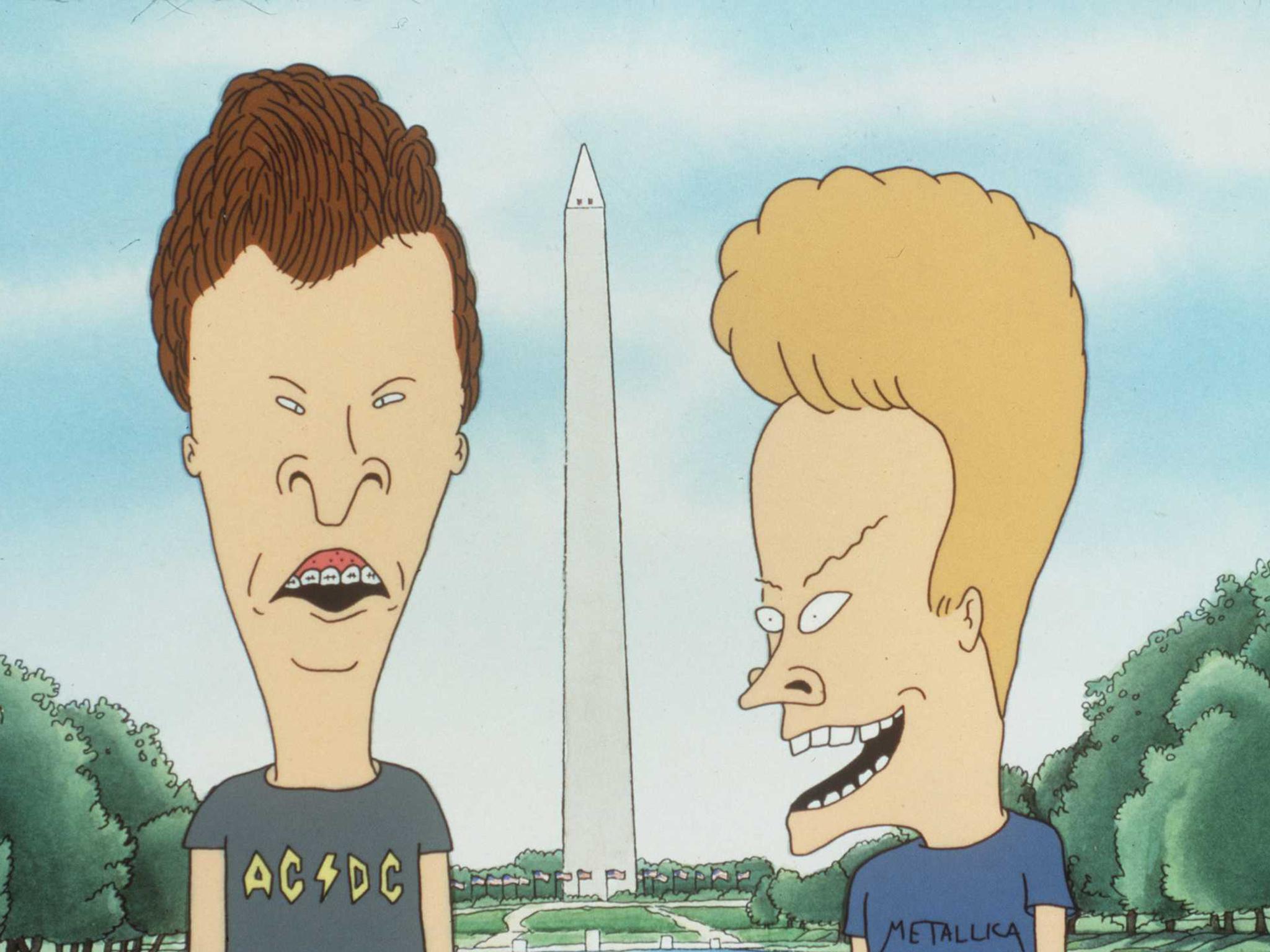
Your support helps us to tell the story
From reproductive rights to climate change to Big Tech, The Independent is on the ground when the story is developing. Whether it's investigating the financials of Elon Musk's pro-Trump PAC or producing our latest documentary, 'The A Word', which shines a light on the American women fighting for reproductive rights, we know how important it is to parse out the facts from the messaging.
At such a critical moment in US history, we need reporters on the ground. Your donation allows us to keep sending journalists to speak to both sides of the story.
The Independent is trusted by Americans across the entire political spectrum. And unlike many other quality news outlets, we choose not to lock Americans out of our reporting and analysis with paywalls. We believe quality journalism should be available to everyone, paid for by those who can afford it.
Your support makes all the difference.Mike Judge’s original run of Beavis and Butt-Head cartoons aired from 1993 to 1997, neatly spanning the first four years of the Bill Clinton administration, a presidency better remembered for the lurid details of the incumbent’s extra-marital affair with White House intern Monica Lewinsky and subsequent impeachment proceedings than its legislative achievements.
Judge’s teenage protagonists – two sniggering, sex-obsessed dunderheads who resented any time spent away from their beloved TV – proved the perfect pair to embody this peculiarly sleazy cultural moment.
A quarter of a century on, the DNA strands of their influence can be traced, in differing quantities, through almost all of the comedy and animation that has followed, from South Park (1997-) to Jackass (2000-02) and The Inbetweeners (2008-10).
But these jabbering masturbators seldom get the recognition they unquestionably deserve, a wrong it’s high time was righted.
If you’re too young to recall their scuzzy antics, Beavis and Butt-Head were clueless nihilists without parental oversight or aspirations, stuck on a couch in a dead-end town with few realistic prospects and no interests beyond heavy metal, boobs and random acts of vandalism.
They watched TV, passed judgement on whether the music videos they saw sucked or not and dropped bowling balls stuffed with explosives from rooftops.
Moronic wasters with zero political conscience, they nevertheless instantly struck a chord with Generation X viewers of MTV, who revelled in seeing their own disaffection and fecklessness faithfully represented and simultaneously sent up on screen.
A phenomenon was born, spawning everything from T-shirts to albums and video games.
Beavis and Butt-Head were both authentic and a highly accurate presentation of adolescents as they actually are – bewildered, in a word – a million miles from the Colgate smiles of Saved By The Bell (1989-93), Dawson’s Creek (1998-2003) and The OC (2003-07).
They were also touchingly co-dependent in the manner of Laurel and Hardy. Soulmates who have nothing else in this world but their companionship and shared sense of humour. There’s real poignancy there, in amongst the relentless torrent of scatological jokes and innuendo, if you care to look for it.

Watch Apple TV+ free for 7 days
New subscribers only. £8.99/mo. after free trial. Plan auto-renews until cancelled

Watch Apple TV+ free for 7 days
New subscribers only. £8.99/mo. after free trial. Plan auto-renews until cancelled
Judge had been studying for a postgraduate degree in maths at the University of Texas when he first began experimenting with home-made animation cells in the late 1980s, acquiring a Bolex 16mm film camera and teaching himself the craft from library books.
A physics graduate and musician who grew up in Albuquerque, New Mexico, Judge had previously worked in the office of a software company developing programming for F-18 fighter jets before relocating to California to take a job with a tech startup. These experiences would provide the basis for two of his best-known live-action productions: the cult movie Office Space (1999) and his current HBO sitcom Silicon Valley (2014-).
Beavis and Butt-Head made their first appearance in the early short “Frog Baseball” in 1992, which Judge sold to MTV’s Liquid Television, beginning his fruitful association with a music video channel whose sheen has faded badly in the intervening years.
Judge had overheard a colleague telling a story about kids whacking amphibians with baseball bats and wondered what kind of person would do something so idiotic and cruel. The underbite and receding gums of Beavis and Butt-Head were his answer, traits borrowed from old school acquaintances and neighbours.
As the ratings rose, MTV demanded new episodes and a cottage industry was set up to produce more shorts.
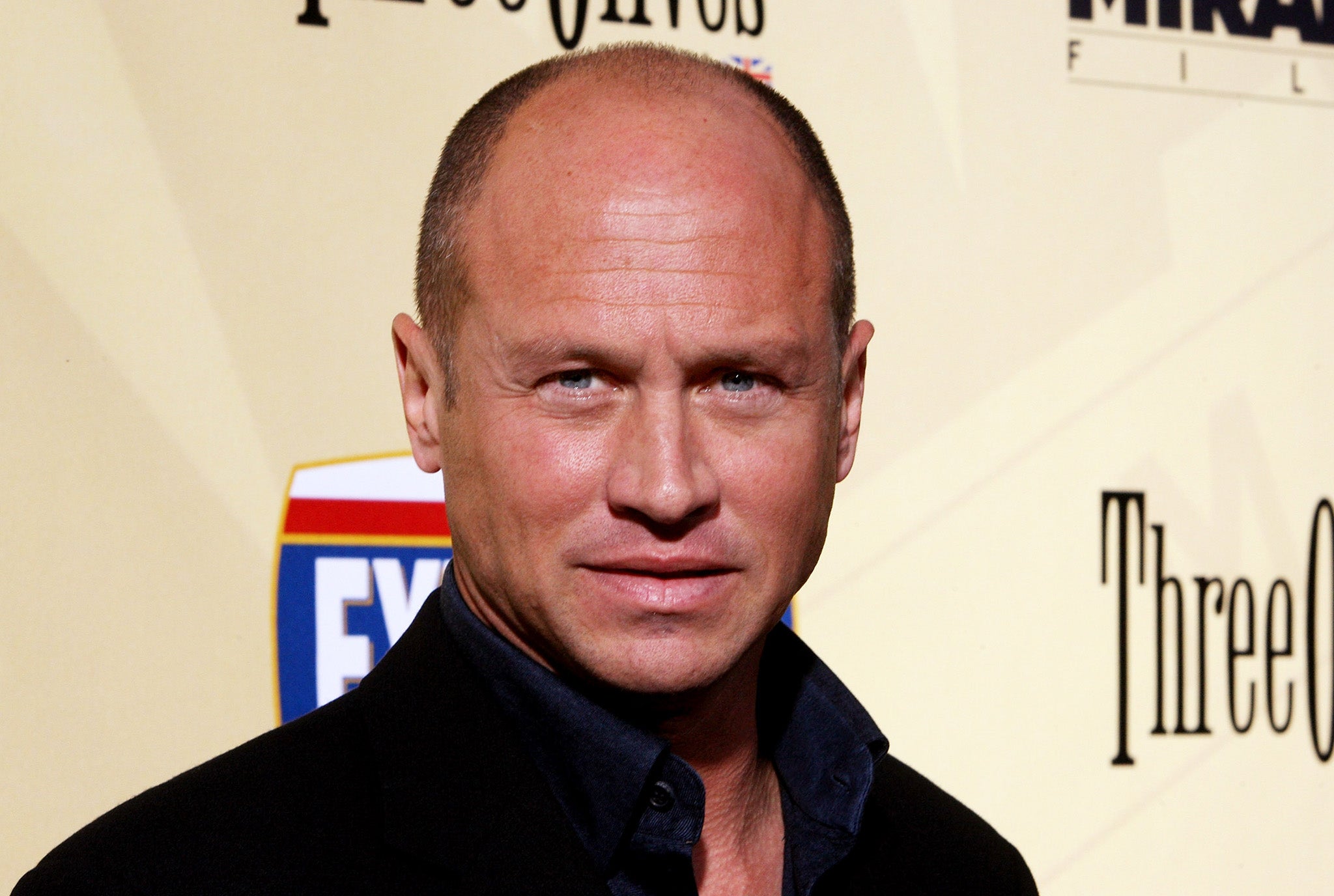
Judge wrote, directed and voiced both of the characters, gradually building outwards to take in Highland High School and the Burger World restaurant where they (don’t) work and adding such memorable supporting players as Principal McVicker, hippy teacher Mr Van Driessen and neighbour Tom Anderson (a prototype for Judge’s next all-American hero, Hank Hill).
Part of the appeal of Beavis and Butt-Head and their successor series King of the Hill (1997-2010) is Judge’s outsider perspective – starting out as a working stiff and hobbyist with no ties to the New York or Los Angeles entertainment scenes – which enabled him to present a truly personal vision of America. The shabby drive-thru parking lots, motel forecourts, scrublands and littered highways he deals in might as well be on a different planet to the Manhattan and Beverly Hills we so often see romanticised at the movies.
The specificity of Beavis and Butt-Head’s tastes and milieu also ensured it rang true. Favouring the rock bands that preceded the grunge era like Black Sabbath, Metallica, AC/DC, Megadeth, Anthrax, Primus, White Zombie and Gwar, Beavis and Butt-Head were both of their moment and slightly off the pace. Cool enough to trash Bon Jovi and Terence Trent Darby but not up to speed with anything more avant-garde.
While the show was a nationwide smash, it didn’t escape controversy. Arriving at a time when the question of violence on television and its possible impact on impressionable young viewers was under scrutiny in conservative circles, Beavis and Butt-Head quickly found itself under the microscope.
The presentation of Beavis as a jittery pyromaniac was blamed for the tragic death of a two-year-old girl when her brother, five, burned down the family’s trailer park home with a cigarette lighter in Moraine, Ohio, in October 1993. CBS anchor Dan Rather set the tone for the national coverage that followed, saying the case would leave Americans asking themselves, “How did we get from Leave it to Beaver to Beavis and Butt-Head?”
The accusation was later disproved, however, when it emerged that the mobile home in question did not have a cable hook-up, meaning the child couldn’t possibly have seen the show – turning attention instead towards the mother who had left them unattended while she went out on a date.
Judge responded in boldly bullish fashion, mockingly altering Beavis’s “Fire! Fire!” catchphrase to “Fryer! Fryer!” in a Burger World scene and sending up the absurdity of the hysteria with an episode in which Beavis and Butt-Head flew a kite in a lightning storm and blamed Benjamin Franklin’s bad influence for their actions.
Only Marilyn Manson has been as eloquent on the nonsense of blaming artists for atrocities carried out by the young.
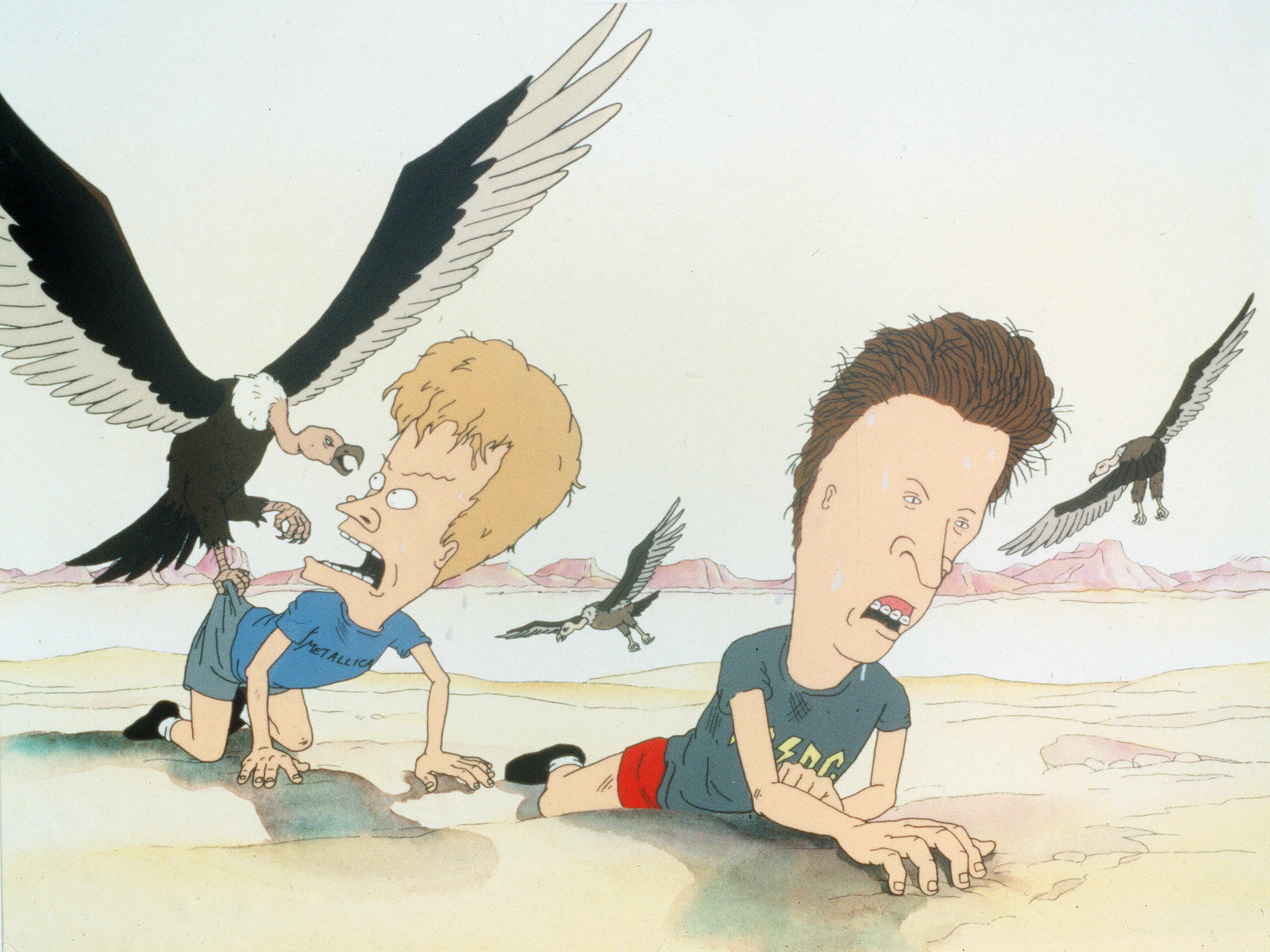
Having successfully weathered this affair with the brand’s popularity untarnished, Hollywood duly came calling. Beavis and Butt-Head Do America was released in December 1996 and broke box-office records for its tricky end-of-year release slot. It is, quite simply, a masterpiece.
The plot is kicked off when the boys wake up to find their TV stolen, sending them outside for once to demand its return, a MacGuffin set-up that predates the soiled rug opening of The Big Lebowski (1998). Running into alcoholic gangster Muddy Grimes (Bruce Willis), the latter assumes they are the hitmen he’s hired to assassinate his arms trafficker ex-wife Dallas (Demi Moore) and dispatches them to Las Vegas to find her.
Beavis and Butt-Head are delighted by the assignment. “You want us to do your wife?” they ask, incredulously, having misinterpreted the key verb. A comic misunderstanding hinging on wordplay – we’re in classical farce territory here, make no mistake.
What transpires is a road movie making Hitchcockian use of national monuments and featuring a biological weapon Beavis doesn’t realise he’s carrying, an anally-fixated ATF agent (Robert Stack), a psychedelic desert dream sequence designed by Rob Zombie and an unauthorised cameo from Chelsea Clinton.
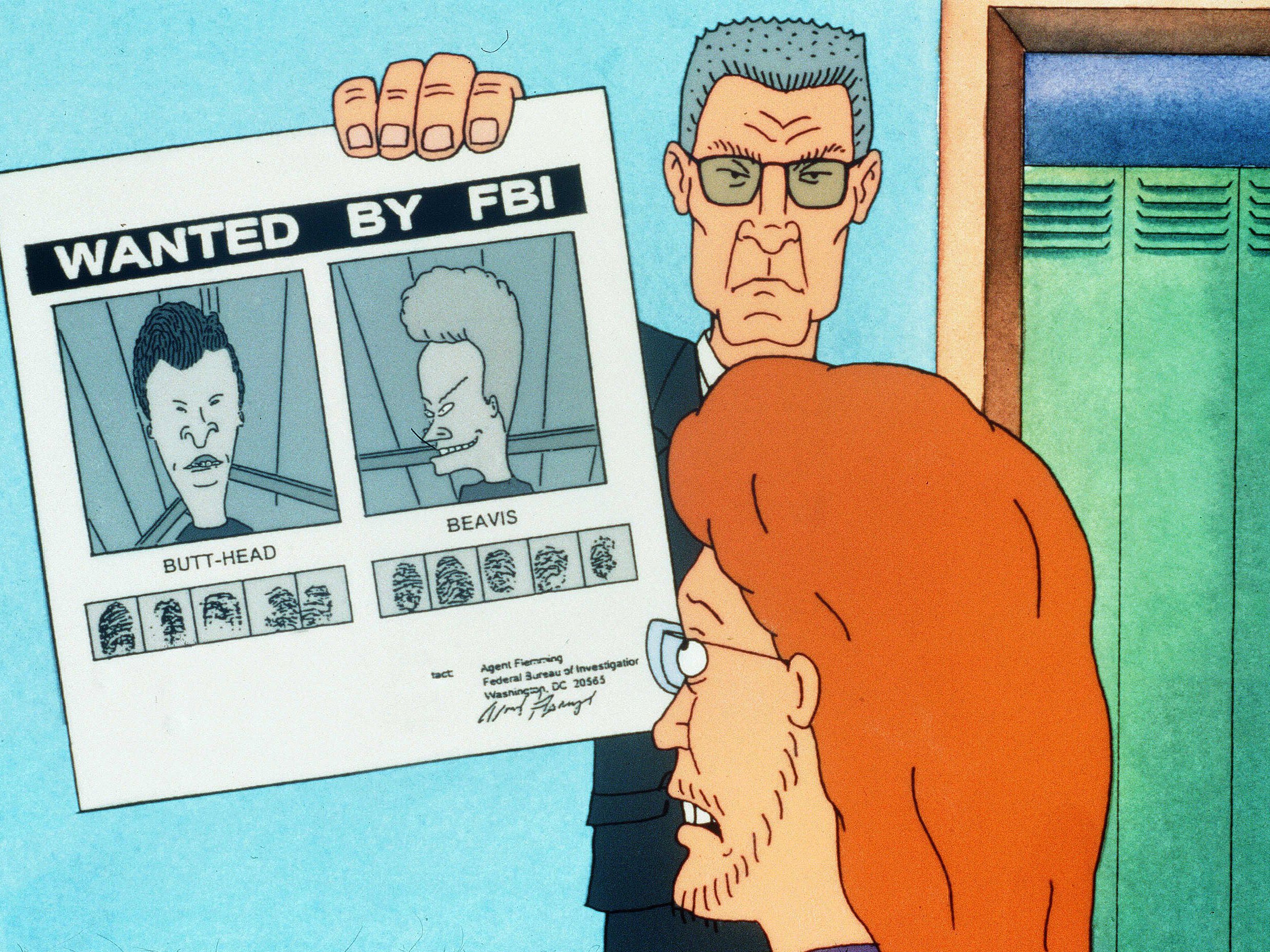
Beavis’s schizophrenic alter ego “the Great Cornholio” makes a return from the series, causing panic on a domestic flight, this time summoned by an overdose of pills to satirise America’s addiction to prescription meds.
There’s also a wonderful assault on cornball patriotism. Anderson parks his much-abused camper van by an idyllic riverside and proclaims: “Boy, I tell you what, it doesn’t get any better than this. This here is God’s country.” Whereupon he is immediately washed away by a Biblical flood caused by Butt-Head’s destruction of the Hoover Dam.
Aside from a brief revival of the series in 2011, in which the guys griped about reality shows instead of music videos, that’s it for Beavis and Butt-Head for now. Judge has kept busy with other projects, the closest in spirit to his breakthrough being the criminally-underrated Swiftian satire Idiocracy in 2006.
But these days nostalgia is big business, so surely we haven’t heard the last of their gormless chuckling just yet.
While Beavis and Butt-Head was wildly popular in its mid-Nineties heyday, it no doubt presents problems for the “woke” modern viewer. There’s plenty of casual homophobia in there and Beavis’s cod-Hispanic accent for Cornholio could certainly cause offence to those interested in seeking it.
The characters themselves, incidentally, would no doubt regard such millennial naysaying as the work of “bungholes”, “dill weeds” and “butt-munches”.
Perhaps what’s most likely to prevent these great comic characters finding a new generation of fans is that the show was always (knowingly) an extremely white and very male product.
There are very few black, Asian or Latino characters in their redneck universe and little interest in their perspective while women largely exist to be ogled or scorned (of course the scorn is more than mutual). One noble exception is their perpetually-unimpressed classmate Daria, who rightly won her own spin-off series between 1997 and 2002.
The dominant interest in 1990s pop culture these days is in reclaiming the work of minority breakthrough artists who blazed a trail in more difficult times, giving the likes of De La Soul, Boyz in the Hood (1991) or the fantastically meme-ready Fresh Prince of Bel-Air (1990-96) their proper due.
This may not be the right time for a Beavis and Butt-Head revival, the pair lacking the same broad crossover appeal and always representing a meaner-spirited proposition. You could certainly never accuse them of being progressive or inclusive, but then that was never the point.
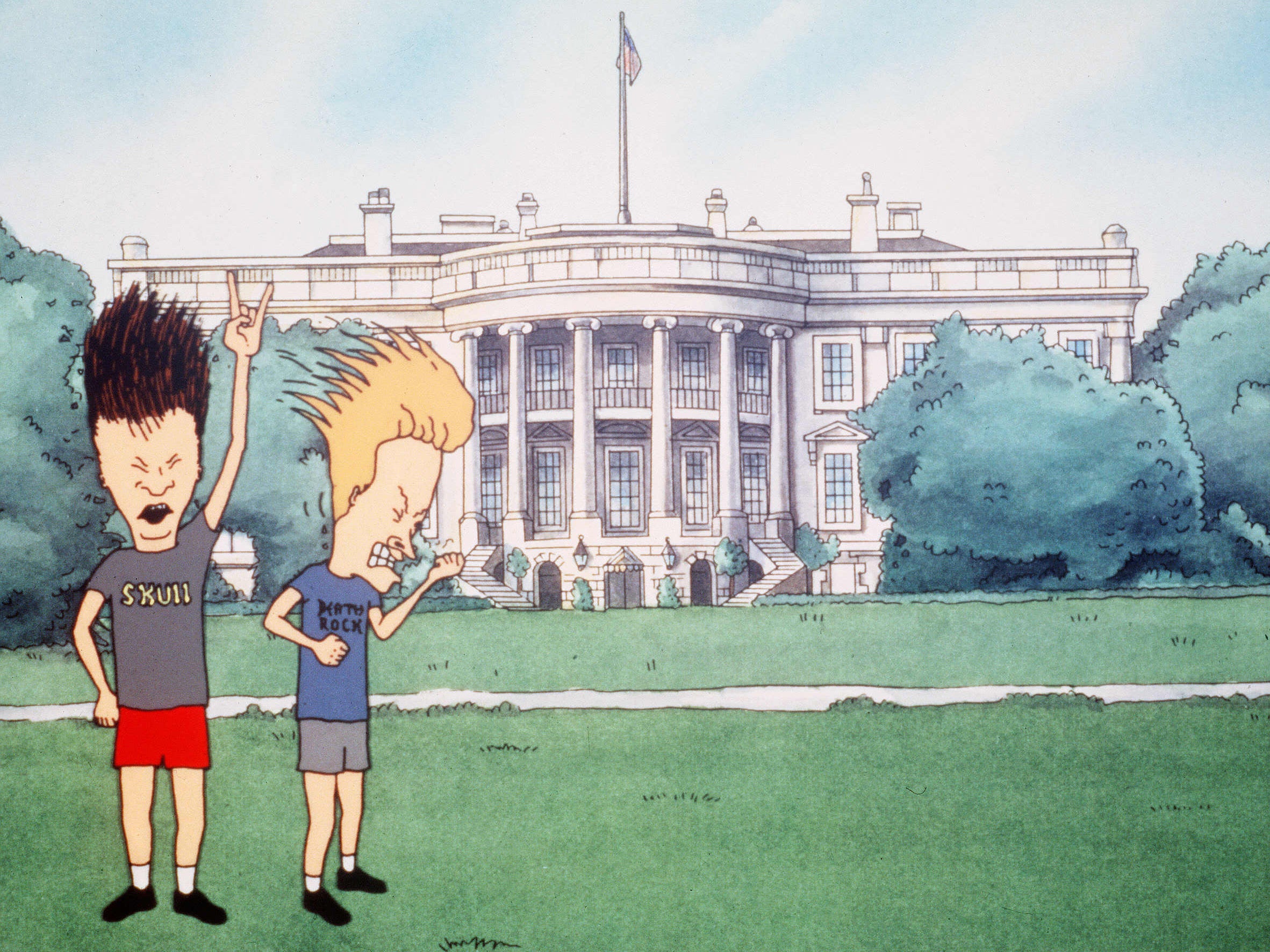
Another potential problem is that, like other contemporary bro double-acts from the Nineties such as Bill and Ted, Wayne and Garth and Jay and Silent Bob, the guys were unreconstructed slackers, which might now be regarded as the ultimate expression of white privilege.
Slackerdom and the stoner drop-out chic that goes with it shirks responsibility, snubs the mainstream and derides conventional expectations in favour of “higher” artistic pursuits that don’t demand compromise.
Which is all very well, but such a cynical stance was not then and isn’t now a realistic option for many minorities in America, born with the chips stacked against them and unable to afford the luxury of affected idleness because hard work remains a necessity for survival.
However, one could make the counter-argument that Beavis and Butt-Head’s very whiteness could hardly be more relevant. They spring from precisely the same quagmire of poverty, neglect and anger as those working-class Republican voters whose disaffection and alienation Donald Trump so successfully tapped into and exploited to win the presidency in November 2016.
Either way, 25 years after they were first broadcast, it seems unthinkable that Beavis and Butt-Head might be no more.
As Judge observed in an interview with podcaster Marc Maron in 2015, “dumbasses are universal”, and with a prime example currently holed up in Washington, what better time to send for the twin emissaries of American idiocy? They’ve even got the bouffant hair.
Only Adult Swim’s Rick and Morty (2013-) currently even comes close to matching Beavis and Butt-Head’s uncompromisingly harsh tone.
Their gleeful offensiveness could actually prove to be precisely what’s needed, a refreshing counter-blast to the prevailing po-faced seriousness of an aggressively glib age.
Join our commenting forum
Join thought-provoking conversations, follow other Independent readers and see their replies
Comments